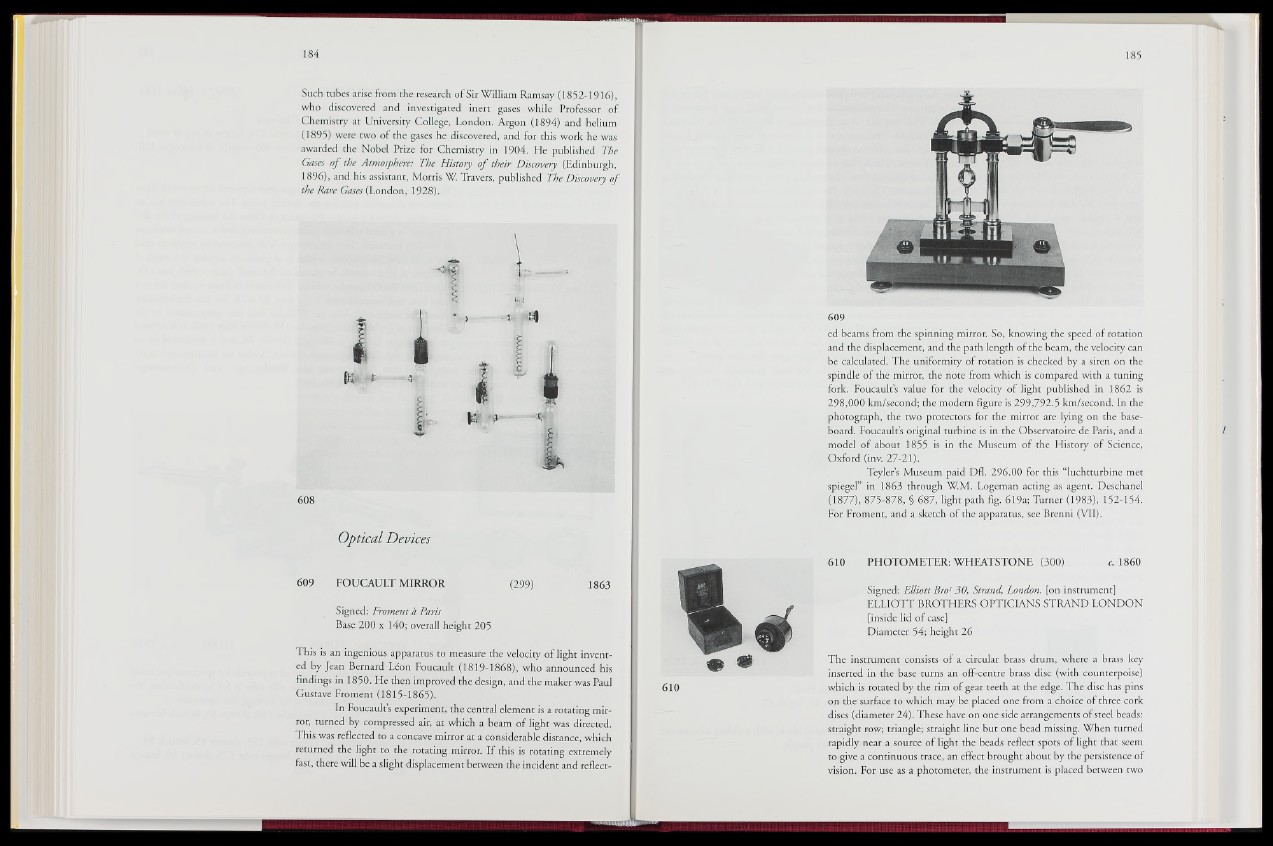
Such tubes arise from the research of Sir William Ramsay (1852-1916),
who discovered and investigated inert gases while Professor of
Chemistry at University College, London. Argon (1894) and helium
(1895) were two of the gases he discovered, and for this work he was
awarded the Nobel Prize for Chemistry in 1904. He published The
Gases o f the Atmosphere: The History o f their Discovery (Edinburgh,
1896), and his assistant, Morris W Travers, published The Discovery o f
the Rare Gases (London, 1928).
608
Optical Devices
609 FOUCAULT MIRROR (299) 1863
Signed: Froment à Paris
Base 200 x 140; overall height 205
This is an ingenious apparatus to measure the velocity of light invent-
ed by Jean Bernard Léon Foucault (1819-1868), who announced his
findings in 1850. He then improved the design, and the maker was Paul
Gustave Froment (1815-1865).
In Foucaults experiment, the central element is a rotating mirror,
turned by compressed air, at which a beam of light was directed.
This was reflected to a concave mirror at a considerable distance, which
returned the light to the rotating mirror. If this is rotating extremely
fast, there will be a slight displacement between the incident and reflect-
609
ed beams from the spinning mirror. So, knowing the speed of rotation
and the displacement, and the path length of the beam, the velocity can
be calculated. The uniformity of rotation is checked by a siren on the
spindle of the mirror, the note from which is compared with a tuning
fork. Foucaults value for the velocity of light published in 1862 is
298,000 km/second; the modern figure is 299,792.5 km/second. In the
photograph, the two protectors for the mirror are lying on the baseboard.
Foucaults original turbine is in the Observatoire de Paris, and a
model of about 1855 is in the Museum of the History of Science,
Oxford (inv. 27-21).
Teyler’s Museum paid Dfl. 296.00 for this “luchtturbine met
spiegel” in 1863 through W.M. Logeman acting as agent. Deschanel
I 8* , 875-878, |1687, light path fig. 619a; Turner (1983), 152-154.
For Froment, and a sketch of the apparatus, see Brenni (VII).
610 PHOTOMETER: WHEATSTONE (300) r. 1860
Signed: Elliott Bros 30, Strand, London, [on instrument]
ELLIOTT BROTHERS OPTICIANS STRAND LONDON
[inside lid of case]
Diameter 54; height 26
The instrument consists of a circular brass drum, where a brass key
inserted in the base turns an off-centre brass disc (with counterpoise)
which is rotated by the rim of gear teeth at the edge. The disc has pins
on the surface to which may be placed one from a choice of three cork
discs (diameter 24). These have on one side arrangements of steel beads:
straight row; triangle; straight line but one bead missing. When turned
rapidly- near a source of light the beads reflect spots of light that seem
to give a continuous trace, an effect brought about by the persistence of
vision. For use as a photometer, the instrument is placed between two